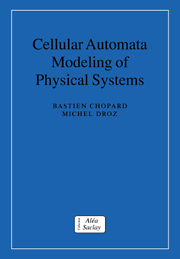2 - Cellular automata modeling
Published online by Cambridge University Press: 26 October 2009
Summary
Why cellular automata are useful in physics
The purpose of this section is to show different reasons why cellular automata may be useful in physics. In a first paragraph, we shall consider cellular automata as simple dynamical systems. We shall see that although defined by very simple rules, cellular automata can exhibit, at a larger scale, complex dynamical behaviors. This will lead us to consider different levels of reality to describe the properties of physical systems. Cellular automata provide a fictitious microscopic world reproducing the correct physics at a coarse-grained scale. Finally, in a third section, a sampler of rules modeling simple physical systems is given.
Cellular automata as simple dynamical systems
In physics, the time evolution of physical quantities is often governed by nonlinear partial differential equations. Due to the nonlinearities, solution of these dynamical systems can be very complex. In particular, the solution of these equation can be strongly sensitive to the initial conditions, leading to what is called a chaotic behavior. Similar complications can occur in discrete dynamical systems. Models based on cellular automata provide an alternative approach to study the behavior of dynamical systems. By virtue of their simplicity, they are potentially amenable to easier analysis than continuous dynamical systems. The numerical studies are free of rounding approximations and thus lead to exact results.
Crudely speaking, two classes of problem can be posed. First, given a cellular automaton rule, predicts its properties.
- Type
- Chapter
- Information
- Cellular Automata Modeling of Physical Systems , pp. 21 - 65Publisher: Cambridge University PressPrint publication year: 1998
- 1
- Cited by



